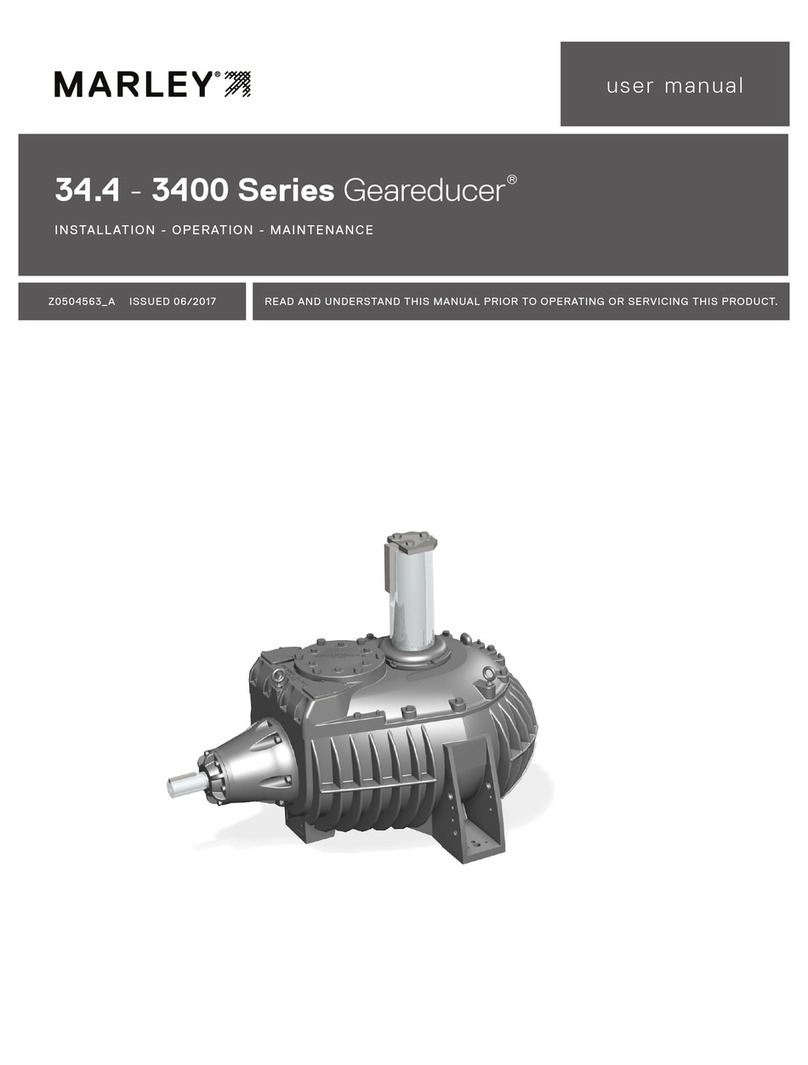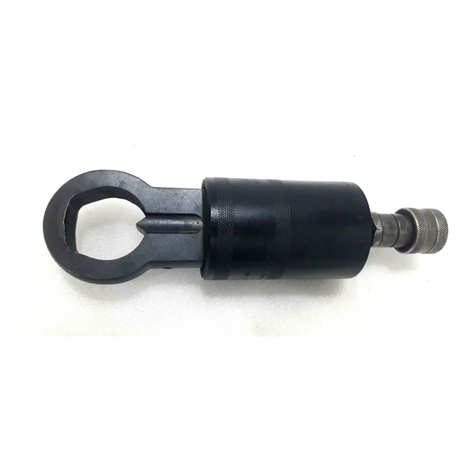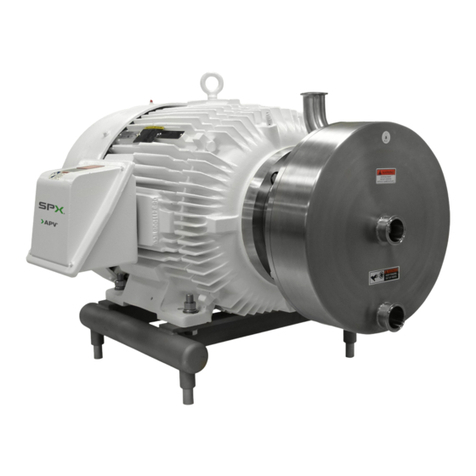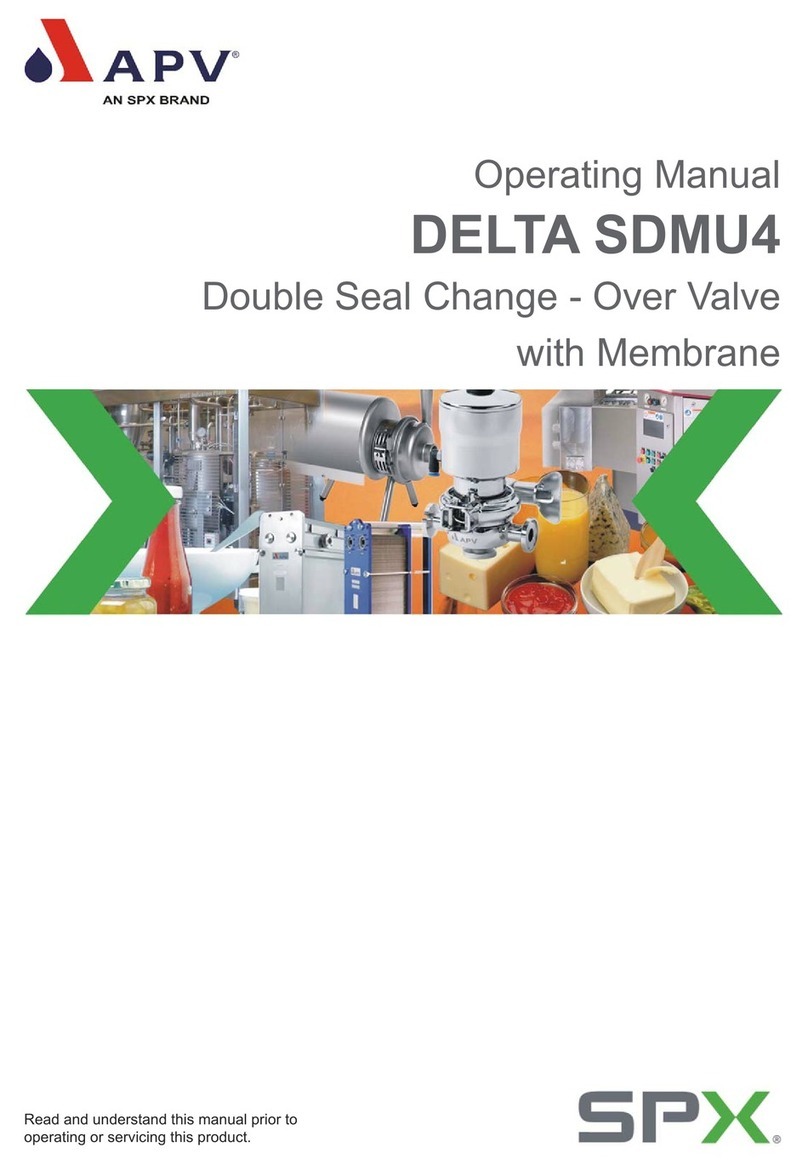SPX Waukesha Cherry-Burrell Votator II User manual

Operation and Maintenance Manual
Scraped Surface Heat Exchanger
Read and understand this manual
prior to installing, operating or servicing this equipment.

611 Sugar Creek Road
Delavan, WI 53115 USA
Tel: (800) 252-5200 or (262) 728-1900
Fax: (800) 252-5012 or (262) 728-4904
E-mail: [email protected]
Web site: www.spxprocessequipment.com
Information contained in this manual is subject to change
without notice and does not represent a commitment on
the part of Waukesha Cherry-Burrell. No part of this
manual may be reproduced or transmitted in any form or
by any means, electronic or mechanical, including
photocopying and recording, for any purpose, without the
express written permission of Waukesha Cherry-Burrell.
Copyright © 2004 All Rights Reserved.
Issued Date: October 2005
Publication: 95-03057

Table of Contents
October 2005 95-03057 Page 3
Waukesha Cherry-Burrell Warranty .........................................................7
Shipping Damage or Loss .............................................................................7
Warranty Claim .............................................................................................7
Safety ..............................................................................................................8
Care of Stainless Steel ..................................................................................9
Stainless Steel Corrosion ..............................................................................9
Elastomer Seal Replacement Following Passivation ....................................9
Introduction ..................................................................................................10
Models and Specifications ............................................................................10
Cylinder Assembly .......................................................................................10
Product Side Pressure Rating ........................................................................10
Jacket Pressure Rating ..................................................................................10
Machine Serial Number ................................................................................10
Votator II Media Configurations ..................................................................10
Special Considerations for Vertical Votator II .............................................10
Installation .....................................................................................................11
Site Selection Considerations .......................................................................11
Foundation & Drainage ..............................................................................11
Clearances .....................................................................................................11
Leveling the Unit ..........................................................................................11
Electrical Power Connections .......................................................................11
Mutator Rotation Check ................................................................................11
Mechanical Seals ..........................................................................................12
Single Mechanical Seal .............................................................................. 12
Double Mechanical Seal ............................................................................. 12
2005 Mechanical Seal Design ....................................................................12
Flush Water Requirements ......................................................................... 13
Piping ............................................................................................................13
Guidelines for Piping .................................................................................. 13
Suggested Media Piping for Water or Liquid ...............................................15
Refrigeration Piping Installation ...................................................................16
Liquid Line Installation .............................................................................. 16
Suction Line Installation ............................................................................ 16
Hot Gas Line (if required) .......................................................................... 16
Pressure Relief Line ................................................................................... 16
Refrigeration Valves .....................................................................................17
Liquid Feed Solenoid Valve .......................................................................17
Dual Pressure Regulating Valve ................................................................. 17
Sporlan Level Master Control (LMC) or Level Switch ............................. 17
Refrigerant Return Valve ........................................................................... 17
Flow Control Valves .................................................................................. 17
Hot Gas Pressure Regulating Valve ........................................................... 17
Pressure Relief Valve ................................................................................. 17
Suggested Media Piping for Liquid Over Feed Refrigeration ......................18
Suggested Media Piping for Gravity Refrigeration ......................................19
Electrical Equipment .....................................................................................21
Refrigeration Wiring Schematics ..................................................................22

Table of Contents
Page 4 95-03057 October 2005
Freeze Protection Components .................................................................. 22
Gravity Refrigeration with Level Master Control (LMC) ......................... 23
Gravity Refrigeration with Level Switch ................................................... 24
Liquid Overfeed Refrigeration System ...................................................... 25
Media System Check ....................................................................................26
Special Considerations for Vertical Votator II .............................................26
Minimum Height - Vertical Votator II .........................................................26
Mounting Pole - Vertical Votator II .............................................................26
Mounting Scrape Cylinders - Vertical Votator II .........................................26
Hydraulic System - Vertical Votator II .........................................................27
Check and Adjust Hydraulic Cylinder ....................................................... 27
Fill Hydraulic Reservoir ............................................................................ 27
Check Balance and Pressure Settings ........................................................ 27
Gravity Refrigeration System - Vertical Votator II ......................................28
Operation ...................................................................................................... 29
Pre-Startup Check .........................................................................................29
For Refrigeration Units Only ..................................................................... 29
Pre-production Run Setup .............................................................................29
Startup Procedure ..........................................................................................29
Heating/Liquid Cooling Applications ........................................................ 29
Refrigeration Applications - Pumped and Gravity Systems ...................... 30
PLC Maintenance Setup and Startup Procedures for Refrigeration .......... 30
Refrigeration Applications - Pumped and Gravity Systems - PLC Panel . 31
Refrigeration Sequence of Operation ...........................................................35
Liquid Overfeed System ............................................................................ 35
Gravity Systems ......................................................................................... 35
Refrigeration Sequence of Operation - PLC Control Panel ..........................36
Liquid Overfeed System ............................................................................ 36
Gravity Systems ......................................................................................... 36
Shutdown Procedure .....................................................................................37
Preventing Tube Scoring ..............................................................................37
Maintenance .................................................................................................. 38
Routine Maintenance Checklist - Vertical Votator II ...................................38
Routine Maintenance Checklist - Horizontal Votator II ...............................39
Scheduled Maintenance ................................................................................40
Preventive Maintenance ................................................................................41
Mutator Shaft Bearing ..................................................................................41
Extra Heavy Duty Votator II Shaft Bearing .............................................. 41
Shafts ............................................................................................................41
Gear Drive .....................................................................................................41
Blades ............................................................................................................41
Mechanical Seals ..........................................................................................42
Tubes .............................................................................................................42
Care of Heat Exchanger Tube .......................................................................42
Product Side ..................................................................................................42
Inspection of Chrome Plated Nickel or Stainless Steel Tubes ......................43
Inspection of Stainless Steel Tubes ..............................................................43

Table of Contents
October 2005 95-03057 Page 5
Jacket Side ....................................................................................................43
For Units Using Steam, Water, Or Liquid ..................................................43
For Units Using Refrigerant ....................................................................... 43
Cleaning the Flanges .....................................................................................43
Leak Testing .................................................................................................43
Scraper Blade Maintenance ..........................................................................44
Blade Inspection ......................................................................................... 44
Scraper Blade Removal & Replacement .................................................... 44
Scraper Blade Wear .................................................................................... 44
Blade Sharpening ....................................................................................... 44
Maintenance of Horizontal Votator II ..........................................................45
Shaft Removal - Horizontal Unit ................................................................ 45
Shaft Installation - Horizontal Unit ............................................................46
Heat Exchanger Tube Removal - Horizontal Unit ..................................... 47
Heat Exchanger Tube Installation - Horizontal Unit ..................................48
Maintenance of Vertical Votator II ...............................................................48
Shaft Removal - Vertical Unit .................................................................... 48
Shaft Installation - Vertical Unit ................................................................ 49
Heat Exchanger Tube Removal -Vertical Unit .......................................... 50
Mechanical Seal Maintenance ......................................................................52
Single Mechanical Seal .................................................................................52
Seal Head Insert Removal and Installation ................................................ 52
Seal Body Insert (Rotating Seal Face) ....................................................... 52
Single Mechanical Seal Installation ...........................................................53
One-Piece and Double Mechanical Seals .....................................................53
Primary/Secondary Seal Head Insert Removal and Installation ................ 53
One-Piece Primary Seal Body (Rotating Seal Face) ..................................53
Removable Seal Body Insert (Rotating Seal Face) ....................................54
Assembly of Removable Primary Seal Body .............................................54
Secondary Seal Body Assembly (For Double Mechanical Seal Only) ...... 54
Seal Assembly Installation on Shaft ........................................................... 54
Servicing Mechanical Seals - Vertical Votator II ......................................55
Parts Lists ......................................................................................................58
Labels ............................................................................................................59
Cylinder Assembly .......................................................................................60
Latch .............................................................................................................61
Product Heads ...............................................................................................61
Cylinder Assembly - Shaft ............................................................................62
Cylinder Assembly - Removable Tube .........................................................63
Single Mechanical Seal .................................................................................64
Double Mechanical Seal ...............................................................................66
Vertical Refrigeration Piping ........................................................................68
Vertical Frame/Hydraulics ............................................................................70
Shaft Heater (Optional) .................................................................................71
Votator II Recommended Spare Parts ..........................................................72
Addendum .....................................................................................................73
Votator II General Assembly ........................................................................73
Horizontal Refrigeration Assembly ..............................................................74

Table of Contents
Page 6 95-03057 October 2005
Vertical Refrigeration System ......................................................................75
Horizontal Frame Options ............................................................................76
Vertical Mounting Pole/Hydraulics ..............................................................77
Vertical Hydraulic Schematic .......................................................................78
Troubleshooting Chart ................................................................................ 79
Unthawing A Frozen System ........................................................................82
Water and Air in Refrigeration System ........................................................82

Waukesha Cherry-Burrell Warranty
October 2005 95-03057 Page 7
Waukesha Cherry-Burrell Warranty
Seller warrants its products to be free from defect in materials and workmanship for a period of one (1) year from the date
of shipment. This warranty shall not apply to products which require repair or replacement due to normal wear and tear or
to products which are subjected to accident, misuse or improper maintenance. This warranty extends only to the original
Buyer. Products manufactured by others but furnished by Seller are exempted from this warranty and are limited to the
original manufacturer’s warranty.
Seller’s sole obligation under this warranty shall be to repair or replace any products that Seller determines, in its
discretion, to be defective. Seller reserves the right either to inspect the products in the field or to request their prepaid
return to Seller. Seller shall not be responsible for any transportation charges, duty, taxes, freight, labor or other costs. The
cost of removing and/or installing products which have been repaired or replaced shall be at Buyer’s expense.
Seller expressly disclaims all other warranties, express or implied, including without limitation any warranty of
merchantability of fitness for a particular purpose. The foregoing sets forth Seller’s entire and exclusive liability, and
Buyer’s exclusive and sole remedy, for any claim of damages in connection with the sale of products. In no event shall
Seller be liable for any special consequential incidental or indirect damages (including without limitation attorney’s fees
and expenses), nor shall Seller be liable for any loss of profit or material arising out of or relating to the sale or operation
of the products based on contract, tort (including negligence), strict liability or otherwise.
Shipping Damage or Loss
If equipment is damaged or lost in transit, file a claim at once with the delivering carrier. The carrier has signed the Bill of
Lading acknowledging that the shipment has been received from WCB in good condition. WCB is not responsible for the
collection of claims or replacement of materials due to transit shortages or damages.
Warranty Claim
Warranty claims must have a Returned Goods Authorization (RGA) from the Seller before returns will be accepted.
Claims for shortages or other errors, exclusive of transit shortages or damages, must be made in writing to Seller within
ten (10) days after delivery. Failure to give such notice shall constitute acceptance and waiver of all such claims by Buyer.

Safety Waukesha Cherry-Burrell
Page 8 95-03057 October 2005
Safety
READ AND UNDERSTAND THIS MANUAL
PRIOR TO INSTALLING, OPERATING OR SERVICING THIS EQUIPMENT
Waukesha Cherry-Burrell recommends users of our equipment and designs follow the latest Industrial Safety Standards.
At a minimum, these should include the industrial safety requirements established by:
1. Occupational Safety and Health Administration (OSHA), Title 29 of the CFR
Section 1910.212- General Requirements for all Machines
2. National Fire Protection Association, ANSI/NFPA 79
ANSI/NFPA 79- Electrical Standards for Industrial Machinery
3. National Electrical Code, ANSI/NFPA 70
ANSI/NFPA 70- National Electrical Code
ANSI/NFPA 70E- Electrical Safety Requirement for Employee Workplaces
4. American National Standards Institute, Section B11
Attention: Servicing energized industrial equipment can be hazardous. Severe injury or death can result from electrical
shock, burn, or unintended actuation of controlled equipment. Recommended practice is to disconnect and lockout
industrial equipment from power sources, and release stored energy, if present. Refer to the National Fire Protection
Association Standard No. NFPA70E, Part II and (as applicable) OSHA rules for Control of Hazardous Energy Sources
(Lockout-Tagout) and OSHA Electrical Safety Related Work Practices, including procedural requirements for:
• Lockout-tagout
• Personnel qualifications and training requirements
• When it is not feasible to de-energize and lockout-tagout electrical circuits and equipment before working on or near
exposed circuit parts
Locking and Interlocking Devices: These devices should be checked for proper working condition and capability of
performing their intended functions. Make replacements only with the original manufacturer’s renewal parts or kits.
Adjust or repair in accordance with the manufacturer’s instructions.
Periodic Inspection: Industrial equipment should be inspected periodically. Inspection intervals should be based on
environmental and operating conditions and adjusted as indicated by experience. At a minimum, an initial inspection
within 3 to 4 months after installation is recommended. Inspection of the electrical control systems should meet the
recommendations as specified in the National Electrical Manufacturers Association (NEMA) Standard No. ICS 1.3,
Preventative Maintenance of Industrial Control and Systems Equipment, for the general guidelines for setting-up a
periodic maintenance program.
Replacement Equipment: Use only replacement parts and devices recommended by the manufacturer to maintain the
integrity of the equipment. Make sure the parts are properly matched to the equipment series, model, serial number, and
revision level of the equipment.
Warnings and cautions are provided in this manual to help avoid serious injury and/or possible damage to equipment:
DANGER: marked with a stop sign.
Immediate hazards which WILL result in severe personal injury or death.
WARNING: marked with a warning triangle.
Hazards or unsafe practices which COULD result in severe personal injury or death.
CAUTION: marked with a warning triangle.
Hazards or unsafe practices which COULD result in minor personal injury or product or property damage.

Waukesha Cherry-Burrell Care of Stainless Steel
October 2005 95-03057 Page 9
Care of Stainless Steel
Stainless Steel Corrosion
Corrosion resistance is greatest when a layer of oxide film is formed on the surface of stainless steel. If film is disturbed or
destroyed, stainless steel becomes much less resistant to corrosion and may rust, pit or crack.
Corrosion pitting, rusting and stress cracks may occur due to chemical attack. Use only cleaning chemicals specified by a
reputable chemical manufacturer for use with 300 series stainless steel. Do not use excessive concentrations, temperatures
or exposure times. Avoid contact with highly corrosive acids such as hydrofluoric, hydrochloric or sulfuric. Also avoid
prolonged contact with chloride-containing chemicals, especially in presence of acid. If chlorine-based sanitizers are used,
such as sodium hypochlorite (bleach), do not exceed concentrations of 150 ppm available chlorine, do not exceed contact
time of 20 minutes, and do not exceed temperatures of 104°F (40°C).
Corrosion discoloration, deposits or pitting may occur under product deposits or under gaskets. Keep surfaces clean,
including those under gaskets or in grooves or tight corners. Clean immediately after use. Do not allow equipment to set
idle, exposed to air with accumulated foreign material on the surface.
Corrosion pitting may occur when stray electrical currents come in contact with moist stainless steel. Ensure all electrical
devices connected to the equipment are correctly grounded.
Elastomer Seal Replacement Following Passivation
Passivation chemicals can damage product contact areas of WCB equipment. Elastomers (rubber components) are most
likely to be affected. Always inspect all elastomer seals after passivation is completed. Replace any seals showing signs of
chemical attack. Indications may include swelling, cracks, loss of elasticity or any other noticeable changes when
compared with new components.

Introduction Waukesha Cherry-Burrell
Page 10 95-03057 October 2005
Introduction
Models and Specifications
The Votator II can be furnished for horizontal or vertical
installation, available in the following models:
This manual covers the Horizontal and Vertical Votator II,
Concentric and Eccentric Designs, and the Extra Heavy
Duty Votator II. Every attempt has been made to note
where special considerations are needed for each model.
These differences are primarily in the installation and
maintenance of the units.
Cylinder Assembly
The cylinder assembly consists of a rotating shaft inside of
two tubes.The outer tube is called the jacket, and contains
working fluid to heat or cool the contents of the inner,
product tube. The product tube provides a heat exchange
surface for the product.
Standard product tubes are one of the following:
• Pure nickel with a hard chrome plated interior surface.
• Stainless steel with a hard chrome plated interior
surface.
• Stainless steel with no plating.
Product Side Pressure Rating
400 psi (28 bar) @ 400°F (204°C) - Oval Tube
600 psi (42 bar) @ 400°F (204°C) - Std. Votator II
800 psi (56 bar) @ 400°F (204°C) - U Stamp Votator II
Jacket Pressure Rating
250 psi (17.5 bar) @ 400°F (204°C)
150 psi (10.5 bar) @ 400°F (204°C) (oval and high
efficiency tubes)
Check the data plate attached to the Votator cylinder for
exact specifications of the unit.
Machine Serial Number
The machine serial number is stamped on a serial number
nameplate located on the machine side. See Figure 1. The
machine model and serial number should be included with
each parts order.
Votator II Media Configurations
The Votator II is available in the following configurations:
• BWS-BRINE/WATER/STEAM For liquid and steam
heating and cooling applications.
• LIQUID For water or glycol.
• VAPOR For steam or refrigeration.
Special Considerations for Vertical
Votator II
The Vertical Votator II cylinder assembly is shipped for
on-site installation on the mounting pole. When receiving
the shipment, check for the following or multiples of
(depending on the order) shipped separately in their own
crate or crates:
• Scraped Surface Heat Exchanger.
• Frame poles (including attached hydraulic cylinder)
with hydraulic pump & reservoir assembly(s).
• Accumulators, Refrigeration Valves and Piping, if
furnished.
• Mount plates, nuts & bolts, and interconnecting
product piping.
Model Heat Transfer Area Jacket Type
6 x 84 11 ft2(1.0 m2) Steam/Liquid
Refrigeration
6 x 72 9 ft2(0.84 m2) Steam/Liquid
Refrigeration
6 x 48 6 ft2(0.56 m2) Steam/Liquid
Refrigeration
6 x 36 4.2 ft2(0.39 m2) Steam/Liquid
Refrigeration
6 x 24 3.0 ft2(0.28 m2) Steam/Liquid
Refrigeration
Figure 1 - Machine Serial Number Location

Waukesha Cherry-Burrell Installation
October 2005 95-03057 Page 11
Installation
Site Selection Considerations
Foundation & Drainage
The Votator II should be located on a firm foundation,
angled to allow liquids to drain away from the unit.
Clearances
• The rear and sides of the unit, or unit cluster, should
have adequate clearance to provide easy access for
maintenance.
• The front of the Horizontal unit should have the
following minimum clearances to allow for removal
of the mutator shaft:
6 x 84 Votator II - 102 in (259 cm)
6 x 72 Votator II - 90 in (230 cm)
6 x 48 Votator II - 71 in (180 cm)
6 x 36 Votator II - 59 in (150 cm)
6 x 24 Votator II - 40 in (102 cm)
• The bottom of the Vertical unit should have the
following minimum clearances to allow for removal
of the mutator shaft:
6 x 84 Votator II - 96 in (244 cm)
6 x 72 Votator II - 84 in (214 cm)
6 x 48 Votator II - 66 in (168 cm)
6 x 36 Votator II - 54 in (137 cm)
6 x 24 Votator II - 48 in (122 cm)
Leveling the Unit
The Horizontal Votator II should be leveled lengthwise
(along the length of the cylinder) and crosswise by
adjusting the feet on the legs.
For units that will perform CIP, set the level for a forward
pitch of 0.3 degrees (1/16 inch per foot).
If CIP is not required, set the level to what will give the
best drainage for the cylinder.
Electrical Power Connections
DANGER: The Votator II operates with high
voltage. Electrical work should be performed by a
Licensed Electrician in accordance with local
regulations.
The following electrical components for the Votator II
require connection in accordance with the electrical
schematics in this manual, tagged vendor specifications,
and local regulations:
• Drive Motor
Each cylinder is furnished with a 3-phase, multi-
voltage gearmotor with a horsepower rating per the
application:
Std. Votator II accepts 7-1/2 hp (5.5 kw), 10 hp (7.5
kw), 15 hp (11kw) or 20 hp (15 kw); Extra Heavy
Duty Votator II accepts 25 hp (18.8 kw), 30 hp (22.5
kw) or 40 hp (30 kw). Motor is fixed speed and
suitable for use with a variable frequency controller.
•Hydraulic Pump Motor (Vertical units only)
A 3/4 (0.5 kw) horsepower, fixed speed motor. A
variable frequency controller should not be used for
this motor.
•Refrigeration Valves:
liquid feed solenoid valve
dual pressure regulating valve
level switch
hot gas pressure regulating valve
hot gas solenoid valve
•Freeze Protection Components (if furnished):
current sensing relay
instrument current transformer
digital current indicator
Mutator Rotation Check
Correct mutator shaft rotation is counterclockwise when
looking down the unit from the drive end (indicated by a
sticker located near the motor). To check for correct
rotation, momentarily start the drive motor and observe
the rotation of the shaft in the back of the unit.
If rotation of the shaft is incorrect, the drive motor is wired
incorrectly. Have a Licensed Electrician change the wiring
so the rotation of the shaft is correct.

Installation Waukesha Cherry-Burrell
Page 12 95-03057 October 2005
Mechanical Seals
The Votator II is furnished with either a single or double
mechanical seal on both ends of the mutator shaft. Units
furnished before 2005 were installed with either a single or
double mechanical seal configuration. See “2005
Mechanical Seal Design” for units furnished after 2005.
Single Mechanical Seal
The single mechanical seal is normally not flushed but it
can be. It is shipped with a lip seal, (See Figure 2)
designed to contain water or a liquid flush. The spring in
the seal must be removed and the seal reinstalled with the
lip in the relief position to allow flushing. This will
minimize any damage to the contact surface on the stub
end of the shaft.
When the single mechanical seal is rotating, there must be
product or water flow to provide cooling to the rotating
surfaces to avoid permanent damage to the seal assembly.
If the seal is flushed, the fluid flow should be in the range
of 5 to 10 gallons per hour and not exceed 5 psig. Piping to
seals should be in the bottom of head and out the top and
with parallel flow, never in series.
Double Mechanical Seal
The double mechanical seal is furnished with a primary
seal for product and a secondary seal to contain a steam or
water flush.
2005 Mechanical Seal Design
• Units furnished in 2005 and later have a one-piece
chrome-oxide coated rotating body running against a
stationaryceramichead insert.Itcaneasily beconverted
to a double mechanical seal by adding secondary
components to contain a steam or water flush..
Figure 3a - Double Mechanical Seal
Figure 2 - Single Mechanical Seal
Figure 3 - Double Mechanical Seal
Figure 2a - Single Mechanical Seal

Waukesha Cherry-Burrell Installation
October 2005 95-03057 Page 13
Flush Water Requirements
The double mechanical seal must be flushed anytime the
mutator shaft is rotated. Failure to do this will result in
rapid seal failure due to excessive contaminate and heat
build up.
The fluid flow should be in the range of 5 to 10 gallons per
hour, at a temperature of 80°F - 120°F (25°C - 49°C).
Piping to seals should be in the bottom of head and out the
top, piped with parallel flow, never in series.
Piping
Guidelines for Piping
Refer to the general assembly drawings in this manual for
jacket connection sizes and locations, and suggested
media piping drawings.
• Support ALL piping independently.
• Provide for line expansion and contraction.
• Install a safety valve to protect jacket.
CAUTION: The safety valve should be installed
on the discharge side of product pump for safety
and equipment protection.
DANGER: Do not install any positive shutoff
valves downstream of the Votator II unit.
WARNING: Do not allow a volume of liquid to
become isolated in the jacket without relief
protection. Thermal expansion created as liquid
warms can generate enough force to crush tube,
causing damage to internal components and drive
system.
• Provide temperature indicators on both sides of
Votator II unit.
• Provide pressure gauge on discharge side of pump.
• When using liquid coolant, provide a method to
introduce heating media into jacket to thaw
overcooled product.
• Provide liquid coolant system bypass line around unit
to allow coolant system to be brought down to
operating temperature without circulating coolant
through jacket.

Installation Waukesha Cherry-Burrell
Page 14 95-03057 October 2005
The steam solenoid is opened, which lets pressure controlled steam from the boiler into the jacket. A temperature sensor
monitors the temperature of the product and regulates the steam flow to achieve the required temperature. Heating of the
product takes place when the steam condenses into water from the transfer of heat through the jacket.
Table 1: Call Outs For Figure 4
Figure 4 - Suggested Media Piping, Steam
1. Steam IN 7. I/P
2. Strainer 8. Temperature Control
3. By-Pass Line 9. Product OUT
4. Steam Pressure Regulator 10. Product IN
5. Steam Solenoid 11. Drain Valve
6. Temperature Regulator 12. Condensate Trap

Waukesha Cherry-Burrell Installation
October 2005 95-03057 Page 15
Suggested Media Piping for Water or Liquid
The media piping should flow countercurrent to the product flow, and should be circulating at a rate of 50 gpm. The
suggested arrangement automates the source flow to the actual heat exchange requirements to provide maximum control
of the process.
Table 2: Call Outs For Figure 5
Figure 5 - Suggested Media Piping, Water or Liquid
1. Media IN 5. Media OUT
2. Product OUT 6. I/P
3. Product IN 7. Temperature Control
4. Temperature Regulator

Installation Waukesha Cherry-Burrell
Page 16 95-03057 October 2005
Refrigeration Piping Installation
Analyze plant refrigeration load capacity thoroughly. The
system must be sized to adequately support the additional
capacity of this cylinder. All pipes must be clean and free
of oil, chips and sealant residue. Excessive residue in plant
piping can foul and clog cylinder refrigeration valves and
components, causing costly delays in start-up. Refer to
appropriate piping schematic in this manual for Liquid
Overfeed (LOF) or Gravity Refrigeration System.
WARNING: Ammonia or Freon lines should be
installed by fully trained and qualified
Refrigeration Piping Specialists.
Liquid Line Installation
The liquid line should be installed to provide a constant
and steady flow of liquid. Check with system requirements
and plant capacities to ensure that refrigeration piping is
sized properly.
Suction Line Installation
All Votator II refrigeration units operate best when
provided with constant suction pressure. To ensure
constant pressure do the following:
• Size suction header for at least 50% above rated
capacity of cylinder.
• Do not connect to a header already in use by other
equipment with widely varying loads.
• Insulate any suction line that passes through a cold
room to prevent condensate formation. Install a trap
or auxiliary receiver in the line.
CAUTION: A suction trap or auxiliary receiver
should be installed in the line to prevent carry-over
back to compressor.
• Keep suction pressure at compressor as low as
possible. (Lower pressure allows greater cooling
capacity.)
Hot Gas Line (if required)
Review the following guidelines when connecting a hot
gas line to the system:
• Connection of a hot gas line should be from
compressor high side of line past oil trap or separator
to minimize drawing in oil.
• DO NOT run line through a cold room or beside a
cold suction line.
• Slope line away from equipment at 1/8 inch per foot
(1 mm per 100 mm) minimum.
• Install a strainer or filter in addition to recommended
shut-off valves and pressure gauge.
Pressure Relief Line
The pressure relief line MUST be exhausted to the outside
of the building.
Never cap relief line or tie back to suction line.
DANGER: Never install a shut-off valve on this
line. Never vent or connect relief line back to
suction line.
CAUTION: The relief valve is factory set for
appropriate pressure and never needs adjusting.

Waukesha Cherry-Burrell Installation
October 2005 95-03057 Page 17
Refrigeration Valves
Liquid Feed Solenoid Valve
Liquid Feed Solenoid Valve is for on/off control of liquid
refrigerant flow. Valve is closed when de-energized.
Dual Pressure Regulating Valve
Dual Pressure Regulating Valve is shipped loose for
installation in vapor line on discharge side of refrigeration
piping. Valve regulates high-pressure for internal relief
and low-pressure with on/off solenoid valve for process
control. It can be furnished for manual regulating,
pneumatic control with clean, dry, and oil free air from 0-
60 psig, or with a 115 volt motor mounted on the
regulating pilot that responds to a 4-20 milliamp electrical
signal. When using air, a decrease in pressure will lower
the inlet pressure producing a lower temperature.
Sporlan Level Master Control (LMC) or
Level Switch
Gravity Systems with Accumulator are furnished with a
Sporlan Level Master Control (LMC) or a Level Switch.
The LMC is a thermostatic expansion valve with a 15-watt
heater element. As the level in the accumulator drops, the
electrically added heat increases the pressure within the
thermostatic element and opens the valve. As the liquid
level rises, the electrical input is balanced by the heat
transfer from the bulb to the liquid refrigerant and
modulates or shuts off the liquid flow. Minor adjustments
in the level response can be made by adjusting the spring
tension of the expansion valve seat.
If a refrigerant level float switch is provided, single or
double depending upon specifications, it is used to control
the accumulator level by opening or closing a solenoid
operated refrigeration valve. These systems contain that
valve and an expansion valve with a flow indicating scale.
Refrigerant Return Valve
Some Horizontal Votators have a solenoid operated
Refrigerant Return Valve that is in the closed position
when the solenoid is de-energized. This valve is used to
stop the cooling process and is closed if hot gas is applied.
High capacity freon systems have two solenoid valves:
one for hot gas to activate the return valve, the other to
bleed the gas to the suction line.
Flow Control Valves
Liquid Overfeed (LOF) or Pumped Refrigeration Systems
have a manually adjusted Flow Control Valve with setting
scale for refrigerant flow to each Votator cylinder. This
valve maintains a constant flow of liquid to the Votator
and can serve as a check valve to prevent back flow of
liquid during hot gas.
The indicator scale on the valve corresponds to the
refrigeration tonnage. The regulator is set by multiplying
the tonnage load by the desired re-circulation rate. For
example, if the refrigeration load is 10 tons and 200%
(3:1) overfeed is desired, the valve should be set at 30 on
the scale reading.
Hot Gas Pressure Regulating Valve
Systems with hot gas include a solenoid-operated Pressure
Regulating Valve for introducing and maintaining
constant downstream pressure for hot gas inlet.
Pumped Refrigeration Systems include a solenoid
operated Hot Gas Purge Valve for each Votator hot gas
discharge line.
Pressure Relief Valve
This valve is located on the accumulator and should be
exhausted to outside the building. The valve is factory set
to relieve at the design pressure of the accumulator.
DANGER: Never install a shutoff valve in a relief
line.

Installation Waukesha Cherry-Burrell
Page 18 95-03057 October 2005
Suggested Media Piping for Liquid Over Feed Refrigeration
The liquid feed solenoid valve when opened, allows liquid refrigerant to flow into the jacket of the heat exchanger. The
flow is regulated by a manually set flow control valve. Cooling is achieved when the pressure control valve is opened,
causing the pressure in the jacket to be reduced. This causes the liquid refrigerant to change phase, absorbing heat from
the heat exchanger tube and product. The cooling rate is controlled by the back pressure on the system and stops when the
valve is closed. Hot gas is used to push all of the remaining liquid from the system into the ammonia low pressure receiver
and quickly warm the system. The low pressure receiver in the compressor room is designed to separate the liquid from
the vapor before re-compressing.
Table 3: Call Outs For Figure 6
Figure 6 - Suggested Media Piping, Liquid Over Feed or Pumped Refrigeration
1. Safety Relief Valve 10. Dual Pressure Regulating Valve (includes Items 4, 8 and 9)
2. Product IN 11. To Refrigerant Low Pressure Receiver
3. Product OUT 12. Hot Gas Purge Valve
4. Low Pressure Solenoid Valve, see Item 10 13. Flow Control Valve
5. Hot Gas 14. Liquid Feed Solenoid Valve
6/7. Electric Control Signal or Instrument Air
Regulated to 60 PSI
15. Liquid Refrigerant from Low Pressure Receiver
16. Hot Gas Reducing Valve
8. Low Pressure Regulating Valve, see Item 10 17. Hot Gas Solenoid Valve
9. High Pressure Regulating Valve, see Item 10 18. Hot Gas Pressure Regulating Valve

Waukesha Cherry-Burrell Installation
October 2005 95-03057 Page 19
Suggested Media Piping for Gravity Refrigeration
Liquid refrigerant from the receiver is stored in a surge drum located above the Votator II. The level in the surge drum is
automatically controlled by the level system provided with the equipment. Gravity forces the refrigerant into the cooling
jacket where it comes into contact with the heat transfer tube. The warm product causes a portion of the liquid refrigerant
to change phase, causing the heat transfer tube and the product to be cooled. The cooling rate is controlled by the
refrigerant back pressure, and hot gas can be used to push the liquid refrigerant from the Votator cylinder and rapidly
warm the system.
NOTE: Set high pressure regulating valve 5 to 10 psi higher than outlet pressure of hot gas pressure reducing valve and
lower than the relief setting.
Figure 7 - Suggested Media Piping, Gravity Refrigeration - HORIZONTAL

Installation Waukesha Cherry-Burrell
Page 20 95-03057 October 2005
Table 4: Call Outs for Figure 7 and Figure 8
Figure 8 - Suggested Media Piping, Gravity Refrigeration - VERTICAL
1. Safety Relief Valve (Dual) 12. Liquid Refrigerant from Low Pressure Receiver
2. Low Pressure Solenoid Valve, see Item 14 13. Level Control and Liquid Feed Expansion Valve or Level Switch
3. High Pressure Regulating Valve, see Item 14 14. Dual Pressure Regulating Valve (includes Items 2, 3, and 20)
4. To Low Pressure Receiver 15. Hot Gas Reducing Valve
5/6. Electric Control Signal or Instrument Air
Regulated to 60 PSI
16. Hot Gas Solenoid Valve
17. Hot Gas
7. Level Control Heater 18. Drain Valve
8. Normal Operating Liquid Level 19. Product IN
9. Product OUT 20. Low Pressure Regulating Valve, see Item 14
10. Liquid Feed Solenoid Valve 21. Refrigerant Return Solenoid Valve (Horizontal only)
11. Block Valve 22. 1/4" Needle Valve with Regulating Stem (Horizontal only)
This manual suits for next models
5
Table of contents
Other SPX Industrial Equipment manuals
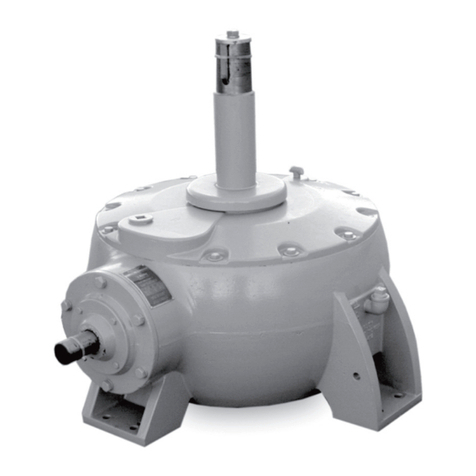
SPX
SPX MARLEY Geareducer 2700 Series User manual

SPX
SPX APV ParaFlow User manual
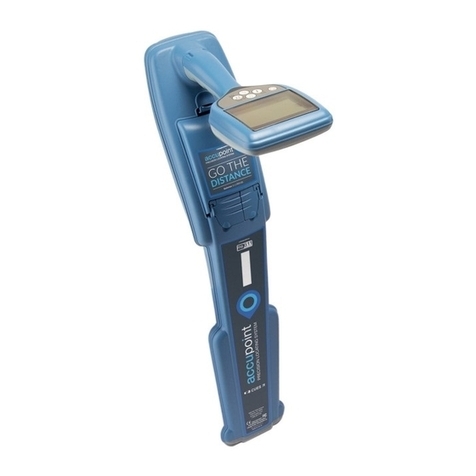
SPX
SPX CUES ACCUPOINT MS611 User manual
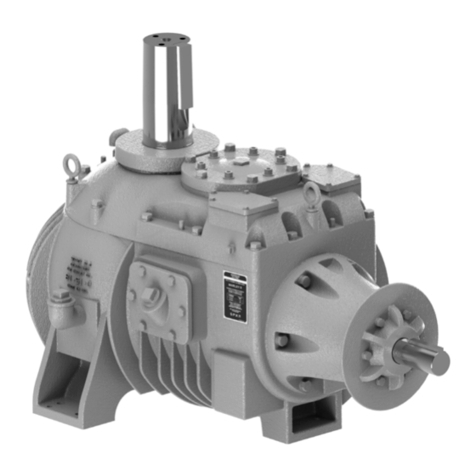
SPX
SPX Marley Geareducer 32.2 Series User manual
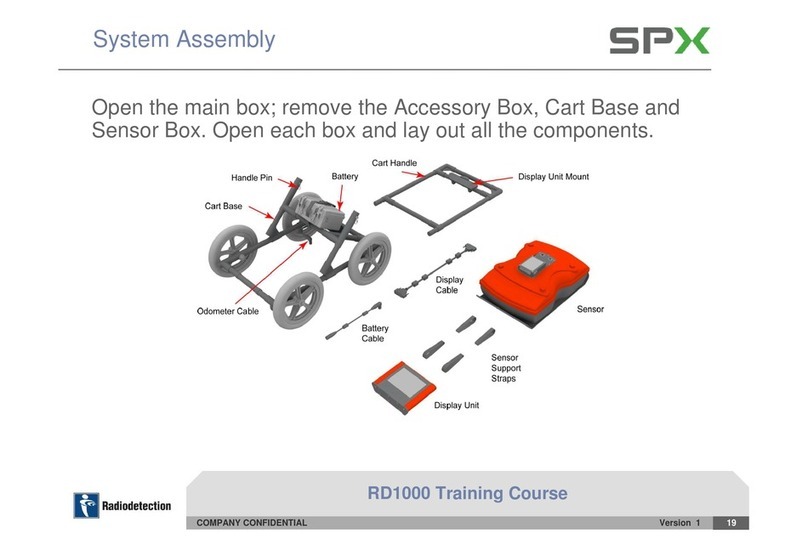
SPX
SPX RD1000 User manual

SPX
SPX Waukesha Cherry-Burrell User manual
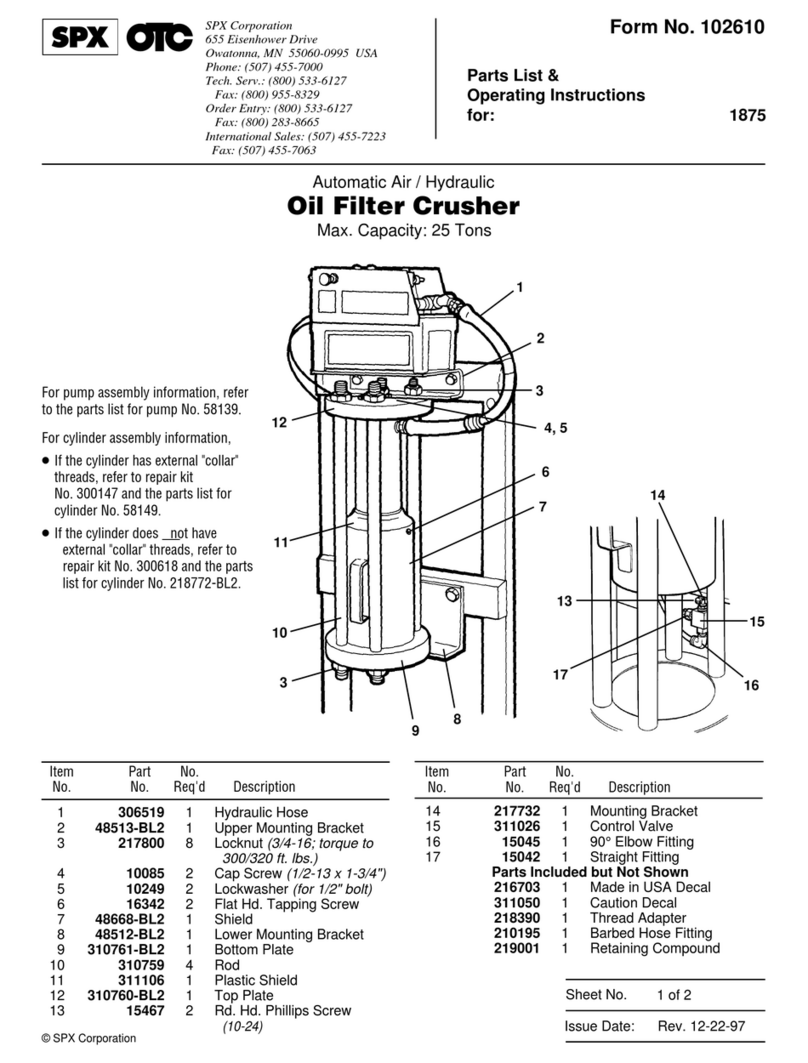
SPX
SPX OTC 1875 User manual
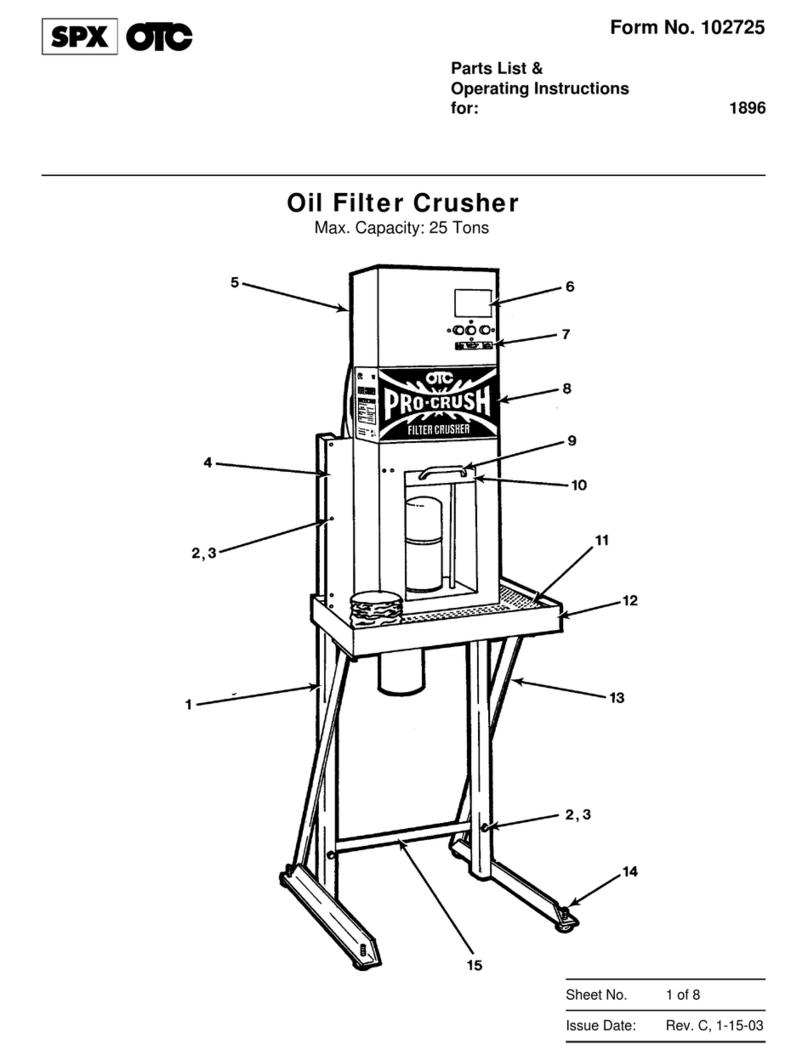
SPX
SPX OTC PRO-CRUSH 1896 User manual
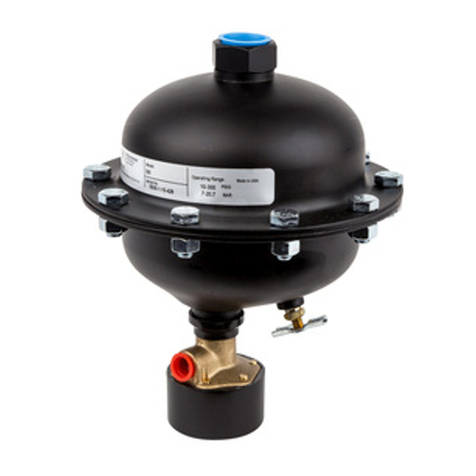
SPX
SPX Hankison Trip-L-Trap 505 User manual
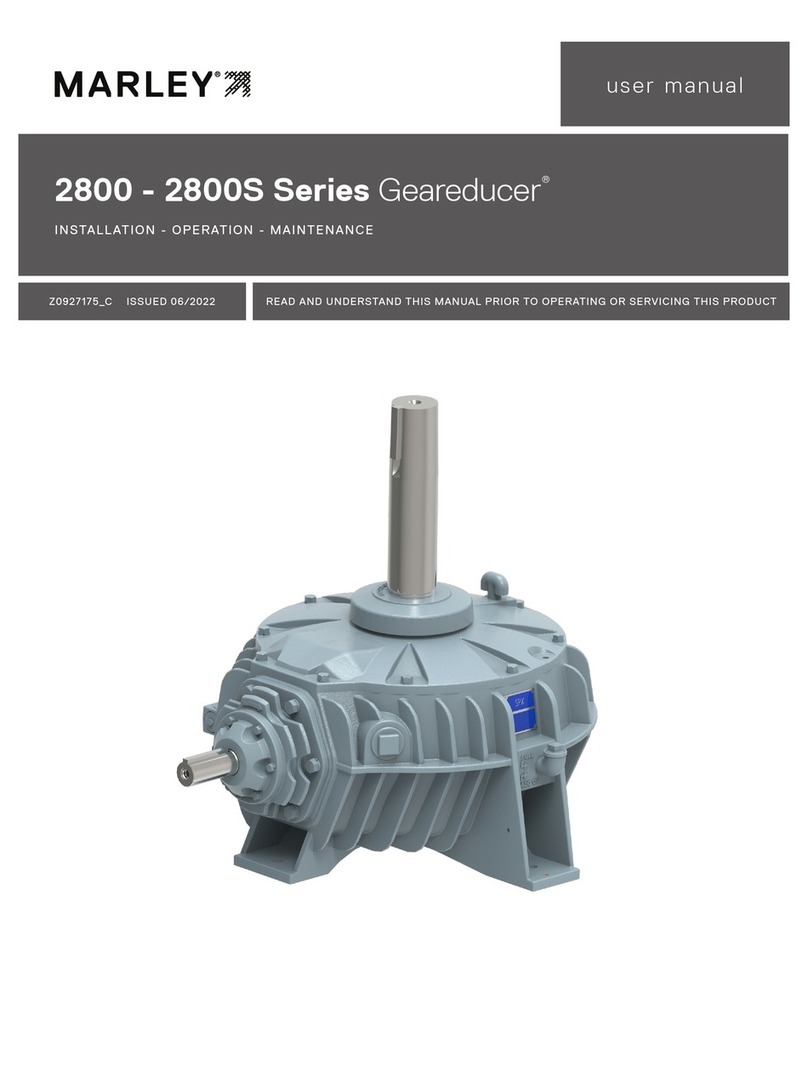
SPX
SPX Marley Geareducer 2800 Series User manual
